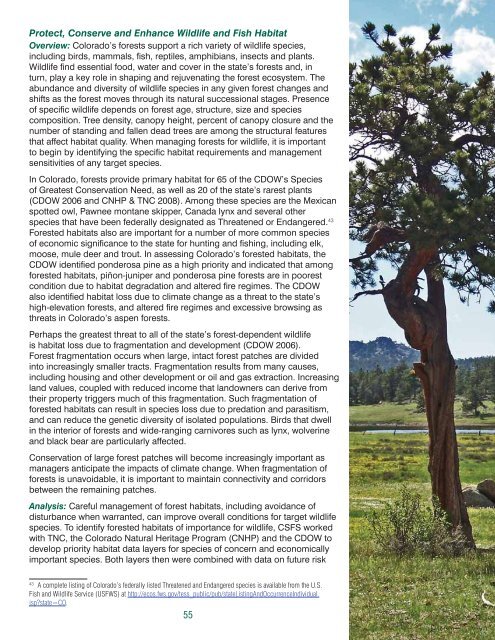Colorado Statewide Forest Resource Assessment
Colorado Statewide Forest Resource Assessment
Colorado Statewide Forest Resource Assessment
You also want an ePaper? Increase the reach of your titles
YUMPU automatically turns print PDFs into web optimized ePapers that Google loves.
Protect, Conserve and Enhance Wildlife and Fish HabitatOverview: <strong>Colorado</strong>’s forests support a rich variety of wildlife species,including birds, mammals, fi sh, reptiles, amphibians, insects and plants.Wildlife fi nd essential food, water and cover in the state’s forests and, inturn, play a key role in shaping and rejuvenating the forest ecosystem. Theabundance and diversity of wildlife species in any given forest changes andshifts as the forest moves through its natural successional stages. Presenceof specifi c wildlife depends on forest age, structure, size and speciescomposition. Tree density, canopy height, percent of canopy closure and thenumber of standing and fallen dead trees are among the structural featuresthat affect habitat quality. When managing forests for wildlife, it is importantto begin by identifying the specifi c habitat requirements and managementsensitivities of any target species.In <strong>Colorado</strong>, forests provide primary habitat for 65 of the CDOW’s Speciesof Greatest Conservation Need, as well as 20 of the state’s rarest plants(CDOW 2006 and CNHP & TNC 2008). Among these species are the Mexicanspotted owl, Pawnee montane skipper, Canada lynx and several otherspecies that have been federally designated as Threatened or Endangered. 43<strong>Forest</strong>ed habitats also are important for a number of more common speciesof economic signifi cance to the state for hunting and fi shing, including elk,moose, mule deer and trout. In assessing <strong>Colorado</strong>’s forested habitats, theCDOW identifi ed ponderosa pine as a high priority and indicated that amongforested habitats, piñon-juniper and ponderosa pine forests are in poorestcondition due to habitat degradation and altered fi re regimes. The CDOWalso identifi ed habitat loss due to climate change as a threat to the state’shigh-elevation forests, and altered fi re regimes and excessive browsing asthreats in <strong>Colorado</strong>’s aspen forests.Perhaps the greatest threat to all of the state’s forest-dependent wildlifeis habitat loss due to fragmentation and development (CDOW 2006).<strong>Forest</strong> fragmentation occurs when large, intact forest patches are dividedinto increasingly smaller tracts. Fragmentation results from many causes,including housing and other development or oil and gas extraction. Increasingland values, coupled with reduced income that landowners can derive fromtheir property triggers much of this fragmentation. Such fragmentation offorested habitats can result in species loss due to predation and parasitism,and can reduce the genetic diversity of isolated populations. Birds that dwellin the interior of forests and wide-ranging carnivores such as lynx, wolverineand black bear are particularly affected.Conservation of large forest patches will become increasingly important asmanagers anticipate the impacts of climate change. When fragmentation offorests is unavoidable, it is important to maintain connectivity and corridorsbetween the remaining patches.Analysis: Careful management of forest habitats, including avoidance ofdisturbance when warranted, can improve overall conditions for target wildlifespecies. To identify forested habitats of importance for wildlife, CSFS workedwith TNC, the <strong>Colorado</strong> Natural Heritage Program (CNHP) and the CDOW todevelop priority habitat data layers for species of concern and economicallyimportant species. Both layers then were combined with data on future risk43A complete listing of <strong>Colorado</strong>’s federally listed Threatened and Endangered species is available from the U.S.Fish and Wildlife Service (USFWS) at http://ecos.fws.gov/tess_public/pub/stateListingAndOccurrenceIndividual.jsp?state=CO.55
















